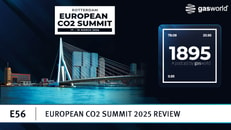Future of Energy event: clean energy weighs its prospects
Policy and market uncertainty continues to cast a shadow over the hydrogen, CCUS and biomethane sectors – and a dedicated session at the Gas, LNG and Future of Energy conference in London explored the latest developments.
Mhairidh Evans, Vice-President Global Head of CCUS Research at analyst group Wood Mackenzie, said, “It looks like the 45Q tax credit, probably the most famous CCS incentive globally, will stay, but almost $4bn of funding for projects has been pulled. So what we’re seeing is players in the US and Canada, to some extent, ‘tap the brakes’ on their investment decisions.”
She said the slowdown is expected to last “for a good year yet”.
Nonetheless, CCUS has a “pretty decent role to play” in addressing Scope 1 emissions for gas production and processing and that also extends to enabling hydrogen and ammonia production, too, even if it will be “small and niche” in tackling overall emissions.
“So that’s in the next five-to-10 years … After that CCS’s impact will expand to address post-combustion, Scope 3 emissions, in industrial sectors like cement and petrochemicals,” she said. “The reality is that carbon capture is a high cost technology. Developments to mitigate costs are a little bit further on the horizon.”
Murray Douglas, Vice-President Head of Hydrogen Research at Wood Mackenzie, said the death of hydrogen “has been greatly exaggerated”.
“We don’t think things are quite as bad as maybe the market sentiment suggests at the moment,” he said. “A lot of that sentiment is generating from the US. But we are still seeing very good progress on blue hydrogen and blue ammonia, particularly from the US Gulf Coast, taking loads of gas demand with it. But those projects have built up quite large uncontracted positions.”
He said progress has been slower in Europe, likewise in the Middle East.
“Everyone is waiting for the results of the Japan CfD auction, and there is additional concern that China is going to disrupt the market, not just with electrolysers but also with ammonia volume into the market. On the green side, China is really racing ahead.”
The lack of infrastructure is the main impediment to hydrogen’s growth and holding back a lot of offtake agreements, he added.
“We’re beginning to some progress in Europe, in Germany, and where things become interesting is the hydrogen-ammonia-methanol side, versus gas, in the marine sector, and which route to take, whether it’s ammonia or LNG.
Rosaline Hulse, Senior Research Analyst for Europe Gas & LNG at Wood Mackenzie, said energy security concerns have continued to drive biomethane interest.
“In Asia, we’re seeing accelerated development with the market scaling up production and improving infrastructure,” she said. “Europe is also seeing significant growth in production capacity.”
But she said Europe’s 35 bcm target by 2030 is currently failing short, by around 5 bcm.
“We see additional upside, provided you’ve got the demand materialising,” she said.
She reiterated the importance of shipping as a significant demand pull, accounting for anything up to half of all biomethane supply demand by 2050.
Much like CCUS, though, she said biomethane costs remain expensive, compounded by feedstock costs, regulatory complexity and infrastructure limitations, as well as competition from other renewables.






















